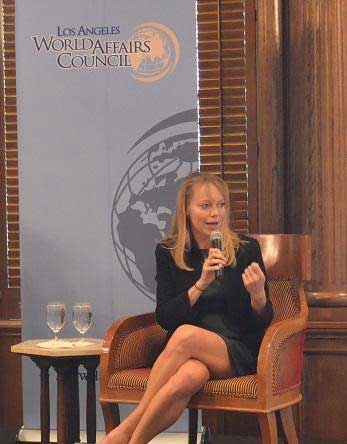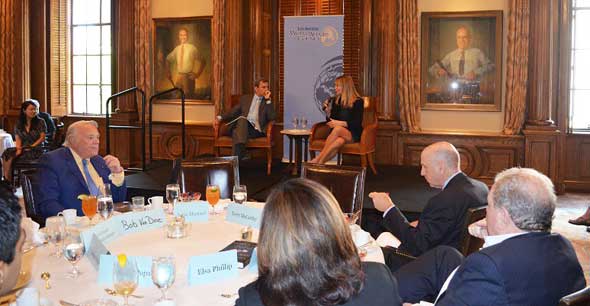
Anja Manuel
At the beginning of the eighteenth century, India accounted for 25% of world GDP, and China accounted for 30% - the two countries together made up more than half of global economic output. But by the end of the Second World War, India was down to 4% and China represented just 5% of global output. Understanding just this, said Anja Manuel, helps to explain the policies and the worldviews of the world's two largest countries, both of whom are often frustrating or mystifying to US policy-makers. The push to regain past power and the memories of oppression condition much of what Chinese and Indian politicians say and do, Manuel told a Roundtable Lunch of LAWAC Directors and International Circle members on Wednesday, June 29th. We need to understand this because by 2030 Asia will have surpassed the US and Europe combined, not just in population, but also in wealth and military spending. "We cannot solve the world's biggest problems - environmental, security, economic - without getting both India and China on board."
Manuel, a lecturer in international relations at Stanford and a co-founder of RiceHadleyGates strategy consultants, said that the US tends to focus too much attention on China, while ignoring much of what is happening in India - a country that is now growing at over 7% a year. China, by comparison, has slowed down - despite official statistics that put China's growth between 6-7%. Manuel said they are not credible - "they will probably grow somewhere between 4-5% this year." But she thought the predictions of the coming collapse of China are misplaced: "China is still fundamentally sound."
One of the biggest differences between India and China is their respective demographic profile - by 2030, 400 million Chinese will be over 60 years old, and just 47% of the population will be of working age. This will put extreme pressure on the state to look after its elderly population. By contrast, in India in 2030 a full 70% of the population will be of working age, potentially enabling an enormous economic boom. India's great challenge, however, is to ensure their "youth bulge" is sufficiently educated to take part in a developing economy. Despite the very high caliber of the graduates from the prestigious Indian Institutes of Technology - many of whom are working in Silicon Valley - the overall level of education in India is very low - currently some 300 million Indians are illiterate. "India needs to train 1-2 million teachers in the very near future," said Manuel, which she said is a huge challenge. "India and China have opposing demographic issues," she said - India needs to educate its youth bulge, China has to manage its retirees.
Manuel said the security picture in Asia is "very bleak - and we should all pay much more attention to this." Half of all arms sales in the world were in Asia last year, and with tensions rising between China and its neighbors, "there is no NATO or any other multilateral military institution to deal with this." Many Asian nations are upset by what they perceive as increasing aggression from China, particularly in the South China and East China Sea. From the Chinese perspective all they see is the US and its allies in Asia seeking to box China in. "China's lifeline is the ocean - 80% of their oil comes through the Malacca Straits... now the US, India, Japan and Australia are having joint military exercises - this is good on the one hand, but on the other hand it just increases China's paranoia about being contained."

Roundtable discussion with Anja Manuel
Manuel, who recently wrote This Brave New World: India, China and the United States, says that China has legitimate economic and military interests surrounding its borders and its access to the ocean. "The task for the US is to find a way to respect China's economic and military interests, without giving in to their nationalism."
As for India, Manuel says that Prime Minister Narendra Modi has clearly put behind him the traditional non-aligned stance of his country. "That is over - they are now clearly on our side - we exercise more with the Indian military than with any other country." In fact, Manuel said, the rapid warming of military-to-military relations between India and the US are so good t hat she fears that in itself will further antagonize China. Pivoting to Asia is not going to be simple, and will require adroit balancing of policy between the two Asian giants.
